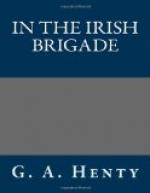Deep was the rage and disappointment among the troops of O’Mahony and Amezaga, as they faced about and set out on their march. They were unmolested. The troops they had beaten were in no disposition to follow them, while the allied cavalry and the infantry of their centre were in full pursuit of the rest of Philip’s army, the remnants of which the little force joined, at Alagon, before nightfall.
It was some days before the archduke’s army moved forward again. The troops were exhausted by the long marches they had made, and there was a difference of opinion among the generals as to the course that had best be followed. The king wished to pursue the beaten enemy and, if possible, to intercept their march towards France, but Count Staremberg and Stanhope were of opinion that they should first occupy Madrid, and then march into Navarre, so as to bar the advance of fresh French troops into Spain, and at the same time open communications by sea with England, whence they could be supplied with reinforcements and stores of provisions.
Finally, Charles gave way, and the allies marched towards Madrid. The main portion of the army halted at Alcala, a day’s march from the capital, and General Stanhope marched on with his division to Madrid, which opened its gates without resistance, Philip having retired with his army. Charles entered the city on the 28th of September, 1710.
The alarm, in France, at the news of the defeat at Saragossa was great, and Louis at once despatched the Duke of Vendome to command there. The latter, travelling fast, and gathering up the garrisons of the towns through which he passed, crossed the frontier at nearly the same time as Charles entered Madrid, and effected a junction with de Bay’s army; which had, by this time, been increased by some fourteen thousand men, drawn from the garrisons of towns in Navarre, Castile, Galicia, and Valencia.
Vendome had no doubt that the intention of the allies, in marching upon Madrid, was to open communication with the Portuguese, and determined to throw himself between the capital and the frontier. Marching with all speed, he encamped near Salamanca on the 6th of October, and thence moved to Plasencia, thereby securing the bridge of Almarez, and preventing the Portuguese from joining Charles.
Had it not been for the usual indecision and want of energy on the part of the Portuguese Government, the junction might have been effected before Vendome arrived at Plasencia, for both Charles and Stanhope had, after the victory of Saragossa, written urgently, begging that the Portuguese army should at once advance and join them at Madrid; and that, at any rate, if the whole army could not move, at least the troops in the pay of England should push forward instantly. Stanhope, indeed had marched with his division to the bridge of Almarez to facilitate the junction, and had defeated a Spanish force guarding the bridge. However, the Portuguese did not arrive; and when a messenger brought the alarming news that a Spanish and French army had occupied Plasencia, Stanhope fell back towards Madrid.




